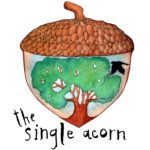
Episode description:
In this series on symbiosis, we’re taking a deep dive into the many different types of relationships organisms have evolved into, the good, the bad, the benign. This episode highlights relationships in which one partner’s a total dud: behold the neutral symbiont. The relationships can be the result of complete and totally unbalanced competition where the other symbiont is harmed (amensalism) or when one species exploits and is benefitted by the resources offered up by the other at no cost to the latter (commensalism: think dung beetles). No species is entirely isolated from the impact of another organism in its environment so we’ll talk about that gray space between commensalism and mutualism, amensalism and exploitation. Welcome to the Single Acorn.
Produced by: Crow’s Path
Hosted by: Professor Eweagey (aka Teage O’Connor), Glenn Etter, Dr. Christine Fleener
Supported by: Our patrons @ patreon.com/CrowsPath
For more natural history:
- Subscribe to the Wild Burlington Newsletter @ crowspath.org/newsletter
- Follow our blog: crowspath.org/blog
- Follow us on instagram: @crowspathvt
Theme music by: Jake Weiss
Logo design by: Caitlin LaDulce
Ads by: Sara Siegel
WORKS CITED
- Hammer pants (link)
- Richard Dawkin’s The Selfish Gene (link)
- Diel vertical migration (DVM) in zooplankton in ponds (link, link)
- Temporal shifts in activity of prey following large predator reintroductions (link)
- The Broken-Wing Behavior of the Killdeer (link)
- Evolution of Black-Tipped Tails in Weasels: Predator Confusion (link)
- A rabbit’s tail: conspicuous rump patch causes predator confusion (link)
- Stotting in Thomson’s gazelles: an honest signal of condition (link)
- Birds of a feather flock together: Insights into starling murmuration behaviour revealed using citizen science (link)
- Tail-flagging and other antipredator signals in white-tailed deer: new data and synthesis (link)
- Chickadees’ alarm-calls carry information about size, threat of predator (link)
- Many eyes or many ewes: vigilance tactics in female bighorn sheep Ovis canadensis vary according to reproductive status (link)
- Position preferences within groups: do whirligigs select positions which balance feeding opportunities with predator avoidance? (link)
- Deer eating fawn poop to mask scent
- Beautiful wood-nymph moth (link)
- Transformers: Snake caterpillars (video)
- An Investigation into Tetrodotoxin (TTX) Levels Associated with the Red Dorsal Spots in Eastern Newt (Notophthalmus viridescens) Efts and Adults (link)
- Why Does Freshly Cut Grass Smell So Nice? (link)







